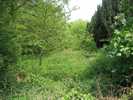For this church:    |
|
 The
Proclamation The
Proclamationof Thanks |
A proclamation of thanks for the Chapel, suitably illuminated, was signed by twenty-nine villagers of Budby and issued to the Earl Manvers in 1888. This was later hung in the Chapel. It is now retained, on loan, at the Dukeries Antiques Centre, Budby.
The Chapel never became a Chapel of Ease in the normal sense, but was owned by the Thoresby Estate, though geographically in Edwinstowe parish.
The Chapel was at that time lit only by candlelight, and so most services were conducted during the hours of daylight. It was properly illuminated for the first time on 25th October 1888.
The Mission Chapel became known locally as the ‘Cocoa Tin’ owing to its brown external colour, and later the ‘Tin Tabernacle’. Many held it with great affection. It was maintained by Mr Leslie John Bland and his wife Ellen for many years. Mr Bland resigned as Treasurer during 1965 after many faithful years of service.
Services were held at regular intervals, but, although the floor was wooden, there was little comfort and it smelt damp and musty.
Population Table from the Church Records
Year |
Edwinstowe |
Budby |
Carburton |
Perlethorpe |
||||
| 1801 | 506 | 145 | 122 | 73 | ||||
| 1851 | 1009 | 147 | 161 | 80 | ||||
| 1901 | 986 | 120 | 148 | 158 |
The continuing depopulation of Carburton, noted in the 1966 Vicar’s Annual repor: “Three houses were demolished, another three are to be, and there are some three others vacant which makes for uncertainty in the future, as does the continuing difficult situation at Budby.”
During 1967 the bell turret collapsed and the general condition of the Chapel came under further scrutiny. It was reported that the cost of the necessary restoration, including rewiring and the provision of adequate heating, would cost something in the region of £300.
The Estate authorities considered this would not be economic, especially when for many years so few had made use of the facilities for worship. It was therefore suggested that the building be demolished, provided that alternative arrangements for worship could be made. Following a personal inspection by the Archdeacon, and in view of the conditions obtaining, it was felt that no other course of action could take place.
It was stated that until such time as the pastoral anomalies of the whole area were ironed out and any re-organisation of boundaries took effect, the facilities for worship would continue to be provided as far as was possible.
The February 1968 Edition of the St Mary’s Edwinstowe, St Giles Carburton and Budby church magazine reports that an evening service at Budby would be held that month (1968), which was to be the last service to be given there. During the service the vicar the Revd Harold Pickles told the congregation, “the Church is first and foremost the people of God and not just a building or place, although we naturally have hallowed associations with such. Whatever we can do to incorporate them into the worship and life of the Church we shall do, and it will still be possible to have services and gatherings in homes, or the reading room.”
The traditional Easter services in April were held at Carburton, transport being arranged to take the Budby parishioners there to the Palm Sunday, Good Friday and Easter Day services.
The Revd Harold Pickles further reported in the March 1968 copy of the magazine: “... the dismantling (of the Budby Chapel) mentioned in my annual report, had taken place.”
The various items of church furnishings were subsequently disposed of. The Altar was sent to St Giles Church Carburton, to replace the one there which was worm eaten through age. The wooden font and 13th Century bell were recovered to the Thoresby Estate wood-yard, pending a decision as to their future disposal. The wooden lectern and church plate were passed into the care of St John the Evangelist Church Perlethorpe. The chairs and pews were generally used to equip the newly formed youth club on the Thoresby Estate, at Home Farm, although several were kept at St John’s Church.
The 13th century bell has been subsequently given to the John Taylor Bell Museum at Loughborough.
Reading Room
The Reading Room was created within the Budby village schoolhouse itself being erected in 1807 at which 18 poor girls would be clothed and educated by the charity of the Lady Manvers, the Earl and his successor.
The inscription over the porch-way of the house reads:
Reading Room |
HEAR INSTRUCTION PROVB CH VII V33 |
A M MDCCCVIII |
BE PIOUS PATIENT |
A monthly service offered by the Vicar of Edwinstowe is maintained at the various parishioners’ homes within the Budby Village.






